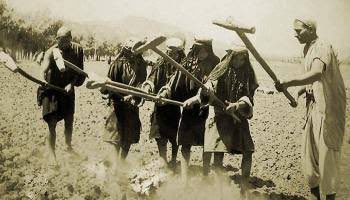Exodus of Kashmiri Muslims.
The word “exodus” has become rhetorical in the Kashmiri political narrative, however, its usage has largely ignored the mass migrations and displacements of poor Muslim peasants and artisans under Sikh and Dogra regimes. (1/n)
The word “exodus” has become rhetorical in the Kashmiri political narrative, however, its usage has largely ignored the mass migrations and displacements of poor Muslim peasants and artisans under Sikh and Dogra regimes. (1/n)
According to ‘Imperial Gazette of India’, 1909, J&K.The enormity of migration was such that in 1891 AD, “The Punjab Census Report enumerated about 1,11,775 Muslim born in Kashmir as having settled in the Punjab. This was equivalent to the entire population of Srinagar. (2/n)
According to the 1911 Census there were 177,549 Kashmiri Muslims in the Punjab. With the inclusion of Kashmiri settlements in NWFP this figure rose to 2,06,180. Kashmiri Muslims migrated to several Punjabi cities such as Sialkot, Lahore, Amritsar and Ludhiana (3/n)
Dogra rule was declared as “Dharam Raj” by Gulab Singh. Dr. Elmslie stayed in visited Kashmir from (1865-1872), says that out of 45 Jagirs only 5 belonged to Muslims (95% of population). Muslim peasants worked as dumb cattle on fields of Pandits and some elite Muslims. (4/n)
The the peasants were also forced to pay the various kinds of taxes on cows, houses, fruit orchards, and household animals etc. The artisans and craftsman were forced to work for rich till they lost their eyes. Under Dogra regime, overburdened taxes were imposed and even (5/n)
income sources were also seized.
John. B Ireland, an American who visited Kashmir in 1850s, exclaimed in wonder that, “on the birth of every lamb the owner must pay a tax of one Anna,.. the birth of calf is four annas. (6/n)
John. B Ireland, an American who visited Kashmir in 1850s, exclaimed in wonder that, “on the birth of every lamb the owner must pay a tax of one Anna,.. the birth of calf is four annas. (6/n)
For a marriage one rupee. A fishing boat four annas per day. Walnut trees ten annas a year for the oil, and if the crop fails, must be made up with ghee”. (7/n)
Kashmir Pandits and elite Muslims on the other had were waived off from such taxes. They were expected to pay only 1 trak for a kharwar wherever they cultivated the land. The muslim cultivator, hence, had to feed not only the Dogra Durbar but the whole contingent (8/n)
of the middlemen between himself and the state, most of whom happened to be Pandits and Pirs.
Similarly, under Dagh Shawl system, Muslim shalbaf (shawl weavers) had to pay Rs. 5 in taxes out of a maximum earning of Rs. 7-8 per month. (9/n)
Similarly, under Dagh Shawl system, Muslim shalbaf (shawl weavers) had to pay Rs. 5 in taxes out of a maximum earning of Rs. 7-8 per month. (9/n)
Baron Charles Hugel, who visited Kashmir in 1840’s wrote with much horror about the shawl manufactories, “One of the most wretched abodes that my imagination could well picture”.
Robert Thorpe in his account recalls the apathy of a worker in shalbaf industry, “Only (10/n)
Robert Thorpe in his account recalls the apathy of a worker in shalbaf industry, “Only (10/n)
death could act his saviour against the exploitation of state.”
The officials additionally benefitted from the sale of of peasant labour (Begar system) to the state and the foreign visitors. The Begar usually consisted of carrying supplies (11/n)
The officials additionally benefitted from the sale of of peasant labour (Begar system) to the state and the foreign visitors. The Begar usually consisted of carrying supplies (11/n)
for the armies (during Gilgit campaign each cultivator had to carry 8 traks per head containing ration for the soldiers), the loads and luggages of foreign visitors around the valley or of the royal processions from one part of the state to another. (12/n)
The poor Muslim peasants were reduced to animals of burden without any hope for wages for such a labour. (13/n)
In this situation the Kashmiri Muslim had only few options to survive, either to bow down before the authority or to migrate from Kashmir. Even migration was also a punishable crime for Muslims. During Ranbir Singh’s time number of Muslim families moved to (14/n)
Lahore and other Muslim majority area to escape from begar and oppression of Maharaja. This is to be said that several migrants were drowned in Wullar Lake as punishment of migration. The Muslims exodus remained one of the least touched topics of Kashmiri political discourse.(n)

 Read on Twitter
Read on Twitter












